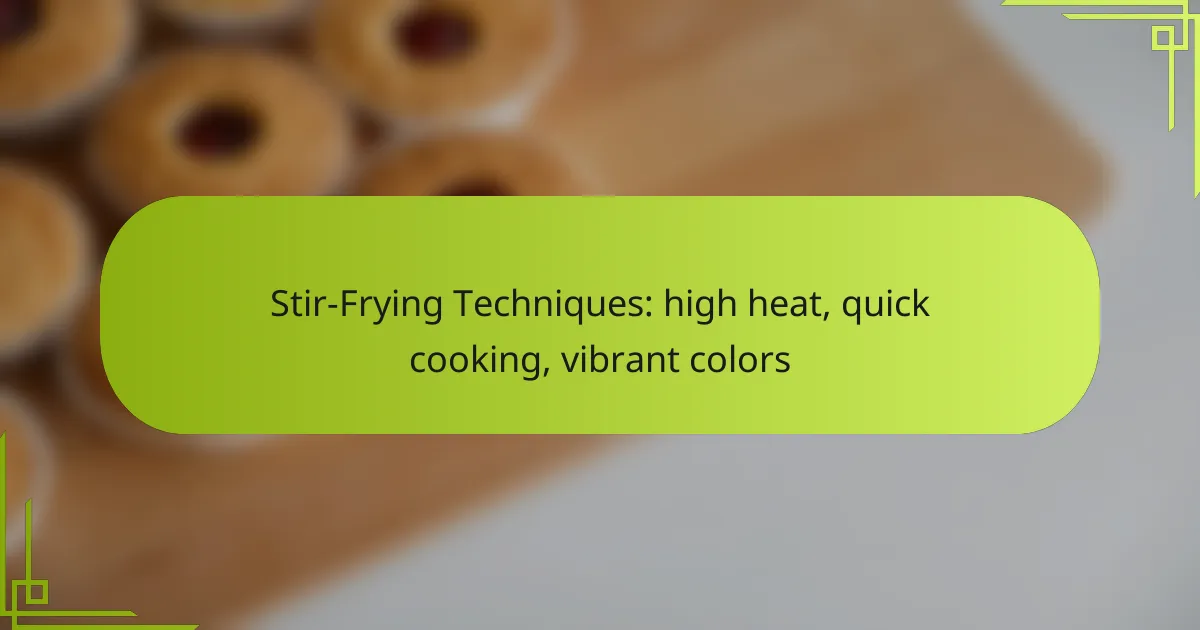Stir-frying is a dynamic cooking technique that emphasizes high heat and quick cooking to create vibrant and flavorful dishes. By mastering this method, you can achieve the perfect balance of textures and colors, making your meals not only delicious but visually appealing. Essential tools and the right choice of oils play a crucial role in maximizing the effectiveness of your stir-frying experience.

How to master stir-frying techniques in London?
To master stir-frying techniques in London, focus on using high heat, quick cooking methods, and vibrant ingredients. These elements are essential for achieving the characteristic flavors and textures of stir-fried dishes.
High heat cooking methods
High heat is crucial for stir-frying as it helps to sear the ingredients quickly, locking in flavors and moisture. A wok is ideal for this technique, as its shape allows for even heat distribution and quick temperature recovery.
When stir-frying, aim for temperatures around 200-250°C (392-482°F). This high heat creates a Maillard reaction, which enhances the dish’s taste and color. Ensure your cooking oil has a high smoke point, such as peanut or canola oil, to withstand the heat without burning.
Quick cooking tips
Quick cooking is key to stir-frying, as it prevents ingredients from becoming soggy. Prepare all your ingredients in advance, cutting them into uniform sizes to ensure even cooking. This preparation allows you to focus on the cooking process without delays.
Cook in small batches to maintain high heat and avoid overcrowding the pan. Stir constantly to ensure even cooking and to prevent sticking. Typically, most vegetables and proteins will cook in just a few minutes, so keep an eye on them to avoid overcooking.
Choosing vibrant vegetables
Choosing vibrant vegetables not only enhances the visual appeal of your stir-fry but also contributes to flavor and nutrition. Opt for a mix of colors, such as bell peppers, broccoli, and snap peas, to create a visually stunning dish.
Freshness is key; select vegetables that are in season for the best taste and texture. In London, you can find a variety of seasonal produce at local markets, which can elevate your stir-frying experience. Aim for a balance of textures, combining crunchy and tender vegetables for a satisfying bite.

What equipment do you need for stir-frying?
To effectively stir-fry, you need a few essential pieces of equipment that facilitate high heat and quick cooking. A wok is the primary tool, but having the right utensils can significantly enhance your cooking experience.
Best woks for home cooks
The best woks for home cooks are typically made from carbon steel or cast iron, as these materials retain heat well and distribute it evenly. A carbon steel wok is lightweight and heats up quickly, making it ideal for high-temperature cooking. Look for a wok with a flat bottom for stability on home stovetops.
When selecting a wok, consider size; a 12 to 14-inch diameter is suitable for most home kitchens. Ensure it has a long handle for easy maneuvering and a helper handle for lifting. Seasoning your wok before use can enhance its non-stick properties and flavor.
Essential utensils for stir-frying
In addition to a wok, essential utensils for stir-frying include a spatula, tongs, and a ladle. A flat spatula is perfect for tossing ingredients quickly, while tongs help in flipping larger items like meat or vegetables. Look for utensils made from wood or silicone to avoid scratching your wok’s surface.
Other useful tools include a lid for steaming and a fine mesh strainer for draining excess oil. Having a good knife for chopping ingredients and a cutting board is also crucial. Remember to keep your utensils close at hand to maintain the quick pace of stir-frying.

Which oils are best for stir-frying?
The best oils for stir-frying have high smoke points and can withstand the intense heat required for quick cooking. Choosing the right oil not only enhances flavor but also ensures that the cooking process is safe and effective.
High smoke point oils
High smoke point oils are essential for stir-frying as they remain stable at the high temperatures typically used in this cooking method. Oils like canola, peanut, and grapeseed have smoke points above 400°F (204°C), making them ideal choices. These oils prevent burning and maintain their nutritional properties during cooking.
When selecting an oil, consider the smoke point alongside the flavor profile. For instance, avocado oil has a very high smoke point (around 520°F or 271°C) and is a great option for those looking for a healthier fat. Always check the label for specific smoke point information to ensure optimal performance.
Flavorful oil options
Flavorful oils can elevate the taste of your stir-fried dishes while still providing the necessary heat tolerance. Sesame oil, for example, is often used for its rich, nutty flavor, though it has a lower smoke point (around 350°F or 177°C) and is best used in combination with higher smoke point oils.
Another option is coconut oil, which adds a subtle sweetness and works well in Asian-inspired dishes. However, its smoke point is around 350°F (177°C) as well, so it should be used carefully. Mixing oils can achieve both flavor and high heat stability, allowing for a more complex taste in your stir-fried meals.

What are the common mistakes in stir-frying?
Common mistakes in stir-frying include overcrowding the pan and using low heat. These errors can lead to uneven cooking, lack of vibrant colors, and a less satisfying texture in the final dish.
Overcrowding the pan
Overcrowding the pan is a frequent mistake that prevents proper heat circulation. When too many ingredients are added at once, they steam rather than fry, resulting in soggy vegetables and proteins.
To avoid overcrowding, cook in smaller batches. Aim for a maximum of two to three servings at a time, allowing enough space for each ingredient to sear properly and develop flavor.
Using low heat
Using low heat during stir-frying can lead to a lack of the characteristic sear and vibrant colors that define this cooking method. High heat is essential for quickly cooking ingredients while preserving their texture and nutrients.
Set your stovetop to medium-high or high heat, depending on your equipment. A well-seasoned wok or a heavy skillet can help maintain the necessary temperature. Always preheat the pan before adding oil and ingredients to achieve optimal results.

How to prepare ingredients for stir-frying?
Preparing ingredients for stir-frying involves cutting vegetables and proteins into uniform sizes to ensure even cooking. This technique allows for quick cooking at high heat, which helps maintain vibrant colors and textures.
Chopping techniques for even cooking
To achieve even cooking, chop ingredients into similar sizes, typically around 1-inch pieces for vegetables and thin strips for proteins. This uniformity promotes consistent heat distribution, preventing some pieces from overcooking while others remain underdone.
Use a sharp knife and a stable cutting board for safety and efficiency. For vegetables like bell peppers and carrots, consider cutting them into matchsticks or small cubes. For proteins, slicing against the grain enhances tenderness and allows for quicker cooking.
Marinating proteins
Marinating proteins before stir-frying enhances flavor and tenderness. A simple marinade can consist of soy sauce, garlic, and a splash of sesame oil, allowing the protein to absorb flavors while also helping to tenderize it.
Marinate for at least 15-30 minutes, but avoid exceeding a couple of hours, as overly long marination can lead to a mushy texture. Keep in mind that different proteins may require different marinating times; for example, chicken benefits from longer marination compared to shrimp.

What are the health benefits of stir-frying?
Stir-frying offers several health benefits, primarily due to its high-heat, quick cooking method that preserves the nutritional value of ingredients. This technique allows for vibrant colors and flavors while minimizing the need for excess fats and oils.
Preserving nutrients
Stir-frying is effective at preserving nutrients because the high heat cooks food quickly, reducing the time it spends exposed to heat. This method helps retain water-soluble vitamins, such as vitamin C and several B vitamins, which can be lost during longer cooking processes like boiling or steaming.
To maximize nutrient retention, cut vegetables into uniform pieces to ensure even cooking. Aim for a cooking time of just a few minutes, stirring constantly to avoid burning and to promote even heat distribution.
Low-fat cooking method
Stir-frying is a low-fat cooking technique since it typically requires only a small amount of oil, often just a tablespoon or two, to prevent sticking. This contrasts with methods like deep-frying, which can significantly increase the fat content of meals.
Choose healthy oils, such as olive or avocado oil, which provide beneficial fats. Additionally, incorporating lean proteins and a variety of colorful vegetables can create a balanced dish without excess calories or unhealthy fats.

How to create a stir-fry sauce?
To create a stir-fry sauce, combine a few key ingredients that enhance the dish’s flavor and texture. A well-balanced sauce typically includes a base of soy sauce, a sweetener, and an acid, allowing for a quick and flavorful addition to your stir-fry.
Basic sauce ingredients
The foundation of a stir-fry sauce usually consists of soy sauce, which provides umami and saltiness. For sweetness, consider using honey, sugar, or a sweet soy sauce variant. An acid, such as rice vinegar or lime juice, adds brightness and balances the flavors.
Additional ingredients like garlic, ginger, and sesame oil can enhance the sauce’s complexity. For a thicker consistency, cornstarch mixed with water can be added to create a glaze-like texture.
Balancing flavors in sauces
Balancing flavors in stir-fry sauces is crucial for a harmonious dish. Aim for a balance of salty, sweet, sour, and spicy elements. Start with a base of soy sauce, then adjust sweetness with honey or sugar, and add acidity with vinegar or citrus juice.
When experimenting, use a taste test approach. Begin with small amounts of each ingredient, gradually adjusting until the desired flavor profile is achieved. Avoid overpowering any single flavor; instead, aim for a well-rounded sauce that complements the stir-fried ingredients.

What are popular stir-fry recipes in the UK?
Popular stir-fry recipes in the UK often feature a mix of fresh vegetables and proteins, cooked quickly over high heat. Dishes like chicken stir-fry with broccoli are favored for their vibrant colors and quick preparation, making them ideal for busy households.
Chicken stir-fry with broccoli
Chicken stir-fry with broccoli is a classic dish that combines tender chicken pieces with crisp broccoli florets, all cooked rapidly in a hot wok. This method preserves the nutrients and bright colors of the ingredients, making the dish visually appealing and healthy.
To prepare this dish, start by slicing chicken breast into thin strips and marinating it briefly in soy sauce, garlic, and ginger. Heat a wok until it’s very hot, then add a small amount of oil before tossing in the chicken. Cook until browned, then add the broccoli and stir-fry for a few minutes until tender yet crunchy.
For best results, ensure all ingredients are prepped before cooking, as stir-frying is a fast process. Avoid overcrowding the wok to maintain high heat, and consider adding a splash of water or broth to steam the broccoli slightly while cooking. This technique enhances flavor and texture without losing the vibrant green color.










